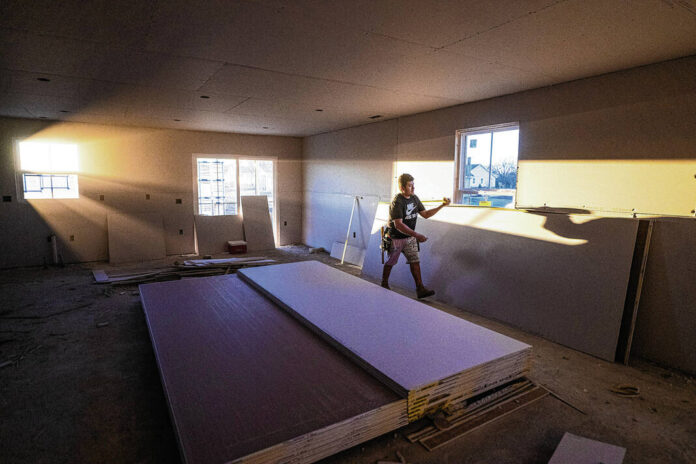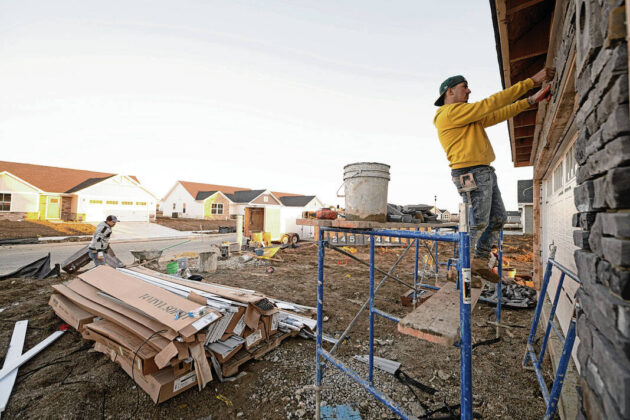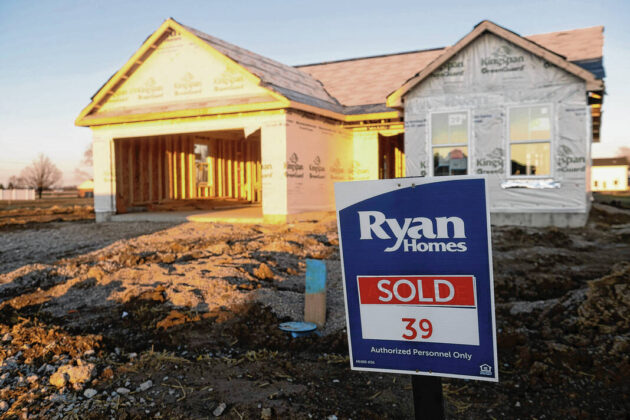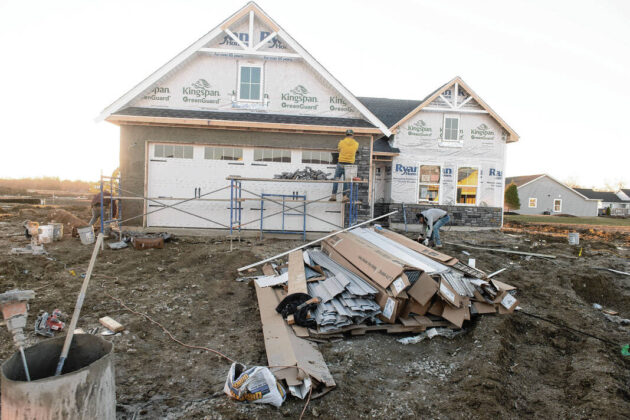
The sun sets through a window as construction on a residential home continues in Greenfield.
Tom Russo | Daily Reporter
HANCOCK COUNTY – While the county has a housing deficit, it’s on track to overcome the shortage in the coming years, according to a report from a nonpartisan research organization.
How well residents will be able to afford those homes, however, does not come with as rosy of an outlook.
The Common Sense Institute prepared the housing report on a 10-county Indianapolis metropolitan area, including Hancock County.
That analysis reports a housing deficit of 2,252 to 3,954 for the county – 6.6% to 11.6% of its existing housing stock.
Tom Joyner, owner of Greenfield-based Joyner Homes, believes there are three main reasons behind the deficit, one of which is supply chain constraints from mid-2020 through late 2022 caused by the COVID-19 pandemic.
“During that period we were actually placing limits on our sales in order to make sure our construction team could keep up,” Joyner told the Daily Reporter in an email. “Secondly, builders were running out of lots, and new developments are very costly and can’t be added overnight.”
Lingering impacts from the Great Recession that began in late 2007 has caused a lot of developers to remain cautious, he continued.
Adam Zaklikowski, planning and building director for the growing Hancock County community of Fortville, noted housing demand – whether for single family or multi-family – remains not only in town and the county, but across the country.
“And the reason for that is I think a very complicated answer and something that really applies to national issues that really do trickle down to here,” he said. “Supply chains have been an issue. Interest rates have slowed down the demand, but I think the bottom line is there’s just not enough housing.”
The report estimates that 4,629 to 6,404 housing permits will be required to close Hancock County’s deficit plus new demand for housing by 2028. Nearly 1,350 permits were issued throughout Hancock County in 2022 through November, the report notes. The document goes on to forecast a surplus of 280 to 576 permitted housing units over the next five years.
Joyner said Hancock County is on track to overcome the deficit because it’s being discovered as a “not-so-hidden gem.”
“People are finding our community from all over the country,” he said, adding that a growing community needs homes.
Affecting affordability
A home-buyer misery index for Hancock County developed by the Common Sense Institute has been climbing steeply over the past couple years, as have indices for the Indianapolis metropolitan area and U.S.
In the last two months of 2022, the misery indices have declined as home prices and mortgage rates have fallen, the report also notes.
“Since 2015, the price of housing in the Indianapolis metro area has exceeded the U.S. average” the report states. “Significant fluctuations in demand during the pandemic, coupled with a growing supply shortage due to lagging development, have created the conditions for a tight housing market. Mortgage interest rates have also climbed from their 30-year historic lows, increasing costs on the purchase of a home.”
In 2006, the average home price in Hancock County wasn’t far above $150,000. In 2022, it was about $300,000 – the fourth highest in the 10-county region – but below the U.S. average of almost $360,000.
“To be fair, historically Indiana has had a very low cost of living, and great career opportunities,” Joyner said. “In the past few years, many large companies have realized that Indiana is a great place to do business, with lower tax burdens, and a hard-working labor force.”
It’s only natural that home values are rising, he continued.
“The good news is that those of us that have been here a while have really benefited from the recent appreciation,” he said. “A lot of wealth in the form of home equity was created over the past couple of years and that equity has allowed for more purchasing power despite the rising prices and interest rates.”
From a planning perspective, a way to help affordability is to allow for smaller housing units, Zaklikowski said.
“But the challenge with that is not every buyer wants a smaller unit,” he added. “Some buyers want a typical suburban home. I’d say in Hancock County, in comparison with other markets – both in metro Indianapolis and around the country – is there’s still a lot of demand for a typical suburban home in a typical suburban neighborhood.”
It’s one of many factors officials weigh as they set out to accommodate the ongoing growth, Zaklikowski continued.
“We want to make sure that every subdivision or neighborhood that is built is of good quality, it can stand the test of time and is well planned,” he said. “We don’t want to mindlessly throw up vinyl boxes just to fill this housing need.”
The Common Sense Institute’s analysis also reports that home-builder confidence has declined by 65% since a recent high in November 2020.
Joyner agreed that his and his colleagues’ confidence level is currently not where it was then, but added the pandemic was a major outlier.
“Our feeling is that things are normalizing rather than declining,” he said. “People still need and want homes.”
Traffic to the company’s model homes is higher than it has ever been, he said.
“Some of the rapid price growth we’ve recently experienced was just getting us back to the historical trend following the low to negative growth period following the 2008 crash,” he said. “Interest rates are also on the rise, but are really just getting back to historical norms. We are currently in the process of entitlement and/or development of three new Hancock County developments for 2023, so we don’t plan to slow down.”







